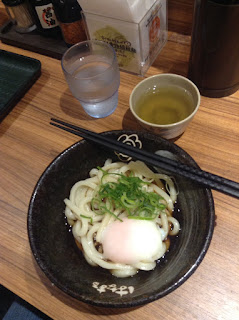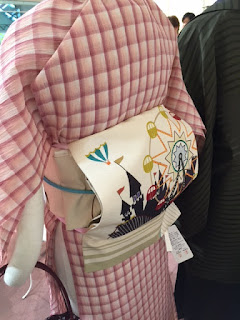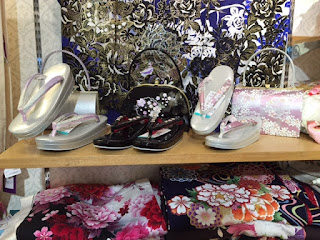Japan is so well known for what was and is staple foods: sushi, udon, ramen. But there is also many different kinds of fusion and foreign influences in cooking styles and food variety. Our focus this week was on the more traditional foods, as well as the numerous bakeries with foreign influence; notably French.
Some of the traditional foods that we've encountered during out time here have been the various types of noodle bowls. Ramen joints are popular and abundant, and tiny fast-food style restaurants dot the streets offering quick bowls of noodles to salarymen and passersby. Udon and soba are the common choices in these style restaurants, whereas ramen is generally served with variations in broth and toppings.
Myles's Thoughts
One of the best parts of being in Japan so far has been enjoying the local food. It’s cheap, it’s delicious, and it’s everywhere. One of my favourite Japanese foods so far has been chicken karaage. Chicken karaage is essentially small pieces of fried chicken, but it’s definitely not like your standard western fried chicken. My best guess is that it has something to do with the cut of meat, seasoning, and breading they use. It’s just so flavourful and the breading, when done well, is just amazing. I’ve had the opportunity to have it on may occasions so far, at a buffet, at our welcome party, on rice from the school cafeteria, and even in curry. Every time it seems to get more and more delicious.
Speaking of food on rice, another very popular dish here is donburi. Donburi is very broadly defined; it could essentially be considered any sort of food placed on top of rice in a bowl. It does, however, illustrate the importance of rice in Japan. Rice is usually considered to be the main part of the dish, with meat, vegetables, and anything else serving as an accompaniment or side dish to the rice. This runs contrary to Western ways of thinking, where the starch is usually considered the side to some sort of meat dish. Thus far, I’ve been able to try karaage don and ten don. No, ten don is not the nasty part of an animal no one wants to eat. The ten comes from the天 in 天ぷら (Romanised as tenpura). Both were delicious, and it was actually really nice to have a lot of plain, hearty rice to cut the richness of the fried foods on top.
 |
| (Karaage don) |
 |
| (Mix curry) |
Lastly, I’ll talk about one of the dishes that Japan is most famous for, sushi. I didn’t actually have sushi for quite sometime after I got to Japan. Then I had a lot of it, all at once. I usually feel sick at just the thought of sushi if I eat it too often, but that hasn’t been the case here. I guess that’s a testament to just how good Japanese sushi is. I think I went to kaitenzushi three times just last week. Kaitenzushi is a type of sushi restaurant where you order sushi on an electronic menu and it’s brought to you on a conveyor belt. The variety of sushi there was awesome. Salmon, unagi (barbequed eel), ebi (shrimp), the list goes on. Unagi is still my favourite by far. It’s light, tender, moist and delicious. One of my new top picks though is maguro (bluefin tuna) sushi. It has such a rich, meaty taste, about as close as you can get to having steak in the fish world. Then there’s all the crazy sushi I’ve had at kaitenzushi. I went once with my host family, at which time the dad just kept telling me to try a piece and take the challenge, and I just kept saying yes. This resulted in me trying uni, kanimiso, and shirako sushi. Uni is also known as sea urchin. I’ve heard it’s supposed to have a rich, buttery taste but that was not the experience I had. It tasted very alkaline and unpleasant, though maybe that was from the leaf in between the sushi and the rice? Kanimiso is basically crab guts. It wasn’t actually that bad, fairly creamy but that taste wasn’t super great and I probably wouldn’t try it again. The last and the weirdest was shirako. I had no idea what it was until I Googled it immediately after eating it. I don’t know if I’ve ever been so surprised after eating something and everyone at the table got a good laugh out of it. Shirako is translated to English as “soft roe”. This translation is completely misleading. For the uninformed, shirako is the organ used by male fish to spray their sperm in species who reproduce by dispersing their gametes in the water. The ponzu jelly it was served with was sour, alkaline, and completely disgusting. I couldn’t even taste the shirako itself. I could, however, feel it. I don’t even know how to describe the texture, but it wasn’t pleasant. I’m told that high quality shirako has a very creamy taste and texture, but I won’t be trying it any time soon. Anyways, I could yammer on and on about Japanese food, it’s one of the things I’m going to desperately miss when I’m gone. But, for now, I’ll end it here. Moral of the story, eat Japanese food, and never stop eating it.
 |
| (Kaitenzushi) |
Sarah's Thoughts
Despite being a very technologically advanced country, Japan still retains a lot of its older traditional foods, which can be found in their breakfast foods, or in the amount of attention and devotion that goes into their food preparation and cooking. 100-yen breakfasts are very cheap, very filling, and often accompanied by miso soup - an old standby for breakfast foods. The foods range from curry, to broiled fish in a mirin-miso sauce, to sandwiches.
Breakfast aside, there are a million different places to eat lunch or supper at. Quick-serving noodle joints, ramen restaurants, curry shops, as well as other country-featured foods like Indian or Italian can be found all nestled along the same street. The noodles are cooked just right, drowning in a bowl of delicious broth: tonkatsu (pork-bone broth) is a staple, as is shio (salt) and shoyu (soy sauce) based broths. Chasiu (pork meat), nori (seaweed) and some green vegetable garnish the noodles, and some places often offer other toppings, such as bamboo shoot, onions, or extras of chasiu or seaweed.
Definitely one thing that I've noticed is that when serving food, there is lots of smaller side-dishes that make up the overall meal. At the homestay, two of the meals consisted of smaller dishes - pickles, salad, rice, and meat and vegetables. And although they are all presented on different plates, there is a cohesion to the flavours. Everything is fresh too, from the fish to the vegetables, which adds to the Japanese tendency to not over-flavour their cuisine.
One of the last things I've noticed about food in Japan is the abundance of French bakeries, and the variety of bread and baking available in konbini and grocery stores. Whatever the reason, French baking and pastries have become commonplace in Japan; there's all kinds of shops selling croissants and rolls, or the crepe stands that litter the sidestreets in Harajuku. The kinds of breads that are sold - like melon pan (bread) or the cream-filled buns - have distinct Japanese touches, like matcha flavouring or lack of sweetener or sugar. Overall, despite being projected as one of the most expensive places in the world, the food is relatively cheap, extremely delicious, and well worth the experience.
Breakfast aside, there are a million different places to eat lunch or supper at. Quick-serving noodle joints, ramen restaurants, curry shops, as well as other country-featured foods like Indian or Italian can be found all nestled along the same street. The noodles are cooked just right, drowning in a bowl of delicious broth: tonkatsu (pork-bone broth) is a staple, as is shio (salt) and shoyu (soy sauce) based broths. Chasiu (pork meat), nori (seaweed) and some green vegetable garnish the noodles, and some places often offer other toppings, such as bamboo shoot, onions, or extras of chasiu or seaweed.
Definitely one thing that I've noticed is that when serving food, there is lots of smaller side-dishes that make up the overall meal. At the homestay, two of the meals consisted of smaller dishes - pickles, salad, rice, and meat and vegetables. And although they are all presented on different plates, there is a cohesion to the flavours. Everything is fresh too, from the fish to the vegetables, which adds to the Japanese tendency to not over-flavour their cuisine.
One of the last things I've noticed about food in Japan is the abundance of French bakeries, and the variety of bread and baking available in konbini and grocery stores. Whatever the reason, French baking and pastries have become commonplace in Japan; there's all kinds of shops selling croissants and rolls, or the crepe stands that litter the sidestreets in Harajuku. The kinds of breads that are sold - like melon pan (bread) or the cream-filled buns - have distinct Japanese touches, like matcha flavouring or lack of sweetener or sugar. Overall, despite being projected as one of the most expensive places in the world, the food is relatively cheap, extremely delicious, and well worth the experience.


















































